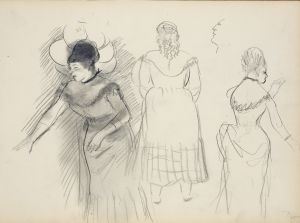
Violinist and Young Woman
A hand-painted replica of Edgar Degas’s masterpiece Violinist and Young Woman, meticulously crafted by professional artists to capture the true essence of the original. Each piece is created with museum-quality canvas and rare mineral pigments, carefully painted by experienced artists with delicate brushstrokes and rich, layered colors to perfectly recreate the texture of the original artwork. Unlike machine-printed reproductions, this hand-painted version brings the painting to life, infused with the artist’s emotions and skill in every stroke. Whether for personal collection or home decoration, it instantly elevates the artistic atmosphere of any space.
"Violinist and Young Woman" is a painting by the renowned French artist Edgar Degas, who is widely recognized for his contributions to the Impressionist movement, although he preferred to be identified as a realist. Degas was born on July 19, 1834, in Paris, France, and became known for his innovative compositions and his focus on capturing the human figure in motion. His works often depict scenes of everyday life, with a particular emphasis on dancers, musicians, and other performers.
The painting "Violinist and Young Woman" is an example of Degas's interest in music and performance, themes that recur throughout his oeuvre. While the exact date of the painting's creation is not definitively known, it is believed to have been completed in the late 19th century, a period during which Degas was actively exploring the world of music and theater in his art.
In this work, Degas presents a scene featuring a violinist and a young woman, capturing a moment of interaction between the two figures. The composition reflects Degas's skillful use of color, light, and shadow to create a sense of depth and intimacy. The violinist is depicted in the act of playing, while the young woman appears to be listening attentively, suggesting a narrative of musical engagement and appreciation.
Degas's technique in "Violinist and Young Woman" demonstrates his mastery of both drawing and painting. He often employed a combination of media, including oil paints and pastels, to achieve the desired effects in his work. This approach allowed him to experiment with texture and form, resulting in a dynamic and lifelike representation of his subjects.
The painting is notable for its composition, which is carefully balanced to draw the viewer's attention to the interaction between the two figures. Degas's use of perspective and spatial arrangement creates a sense of immediacy, inviting the viewer to become part of the scene. The attention to detail in the depiction of the violinist's posture and the young woman's expression further enhances the realism of the work.
"Violinist and Young Woman" is a testament to Degas's ability to capture the nuances of human emotion and interaction. His focus on the subtleties of gesture and expression is evident in this painting, as he conveys the connection between the musician and the listener. This emphasis on the human experience is a hallmark of Degas's artistic vision and contributes to the enduring appeal of his work.
Throughout his career, Degas remained committed to exploring new techniques and subjects, continually pushing the boundaries of traditional artistic conventions. His work has had a lasting impact on the art world, influencing subsequent generations of artists and solidifying his place as one of the leading figures of 19th-century art.
"Violinist and Young Woman" exemplifies Degas's dedication to capturing the beauty and complexity of everyday life. The painting remains an important part of his legacy, reflecting his unique perspective and his ability to convey the richness of human experience through art.


















